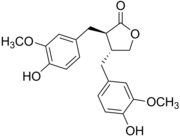Loading AI tools
The lignans are a large group of low molecular weight polyphenols found in plants, particularly seeds, whole grains, and vegetables.[1] The name derives from the Latin word for "wood".[2] Lignans are precursors to phytoestrogens.[1][3] They may play a role as antifeedants in the defense of seeds and plants against herbivores.[4]
Structures of some lignans
- Matairesinol, illustrating the dibenzylbutyrolactone motif
- Secoisolariciresinol, illustrating the 9,9'-dihydroxydibenzylbutane motif
- Justicidin A, illustrating the arylnaphthalene motif
- Pinoresinol, illustrating the furanofuran motif
- Steganacin, illustrating the dibenzocyclooctadienelactone motif
- Podophyllotoxin, illustrating the aryltetralin motif
Lignans and lignin differ in their molecular weight, the former being small and soluble in water, the latter being high polymers that are undigestable. Both are polyphenolic substances derived by oxidative coupling of monolignols. Thus, most lignans feature a C18 cores, resulting from the dimerization of C9 precursors. The coupling of the lignols occurs at C8. Eight classes of lignans are: "furofuran, furan, dibenzylbutane, dibenzylbutyrolactone, aryltetralin, arylnaphthalene, dibenzocyclooctadiene, and dibenzylbutyrolactol."[5]
Many lignans are metabolized by mammalian gut microflora, producing so-called enterolignans.[6][7]
Flax seeds and sesame seeds contain high levels of lignans.[1][8] The principal lignan precursor found in flaxseeds is secoisolariciresinol diglucoside.[1][8] Other foods containing lignans include cereals (rye, wheat, oat and barley), soybeans, tofu, cruciferous vegetables, such as broccoli and cabbage, and some fruits, particularly apricots and strawberries.[1] Lignans are not present in seed oil, and their contents in whole or ground seeds may vary according to geographic location, climate, and maturity of the seed crop, and the duration of seed storage.[1]
Secoisolariciresinol and matairesinol were the first plant lignans identified in foods.[1] Typically, lariciresinol and pinoresinol contribute about 75% to the total lignan intake, whereas secoisolariciresinol and matairesinol contribute only about 25%.[1]
Lignans are the principal source of dietary phytoestrogens in typical Western diets, even though most research on phytoestrogen-rich diets has focused on soy isoflavones. Lignan's enterolignan products enterodiol and enterolactone have weak estrogenic activity, but they may also exert biological effects through non-estrogenic means.[1]
A 2021 review found that lignans have a positive effect on lipid profiles of patients with dyslipidemia related diseases.[10] As of 2022 there is limited evidence that dietary intake of lignans is associated with a reduced cancer and cardiovascular disease risk.[1]
Wikiwand in your browser!
Seamless Wikipedia browsing. On steroids.
Every time you click a link to Wikipedia, Wiktionary or Wikiquote in your browser's search results, it will show the modern Wikiwand interface.
Wikiwand extension is a five stars, simple, with minimum permission required to keep your browsing private, safe and transparent.





